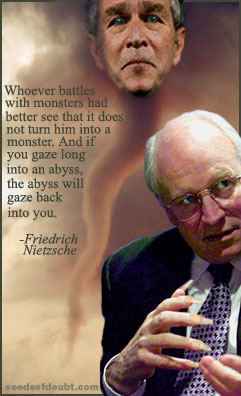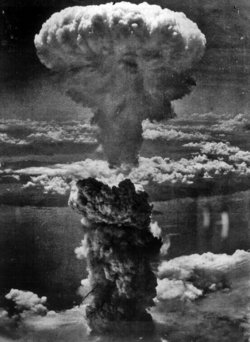By Eric Alterman, Center for American Progress
Posted on January 19, 2006, Printed on January 22, 2006
http://www.alternet.org/story/30949/
One of the central problems for scholars seeking to study ideological bias in the media is the lack of agreed-upon data. Natural scientists and even most social scientists can run experiments where their variables are to a considerable extent controlled. But this is simply impossible in the coverage of politics. An impeachment scandal over a fib about extramarital sex is simply not comparable to misleading the nation into war -- no matter what one might think of either example. Ironically, right-wingers who spend so much time vilifying genuine academic knowledge are more than happy to embrace it when it serves their purpose, no matter how fundamentally flawed it might be. We've seen this tendency for more than a decade with the frequent flying of the flag of a nearly useless study, such as that of the voting habits of Washington reporters done for the 1992 election -- discussed at length in my book, "What Liberal Media?" -- and we're seeing it again today with a recently published study by two conservative media critics currently ensconced in academia.
The study, "A Measure of Media Bias" by UCLA Professor Timothy J. Groseclose and Jeffrey D. Milyo of the University of Missouri-Columbia, purports to demonstrate that the mainstream media lean leftward. It does so by allegedly estimating "scores for several major media outlets," by counting the number of times "a particular media outlet cites various think tanks and policy groups, and then compar[ing] this with the times that members of Congress cite the same groups." Rick Scarborough, a Baptist preacher in Pearland, Texas, has even called on his followers to "join Vision America in our New Year Resolution to Boycott Liberal Media" in 2006, claiming, in his regular newsletter, "a recent study by two university scholars has given a factual basis to what we have known to be true."
As a spokesman for the Dow Jones Co., publisher of the not-so-liberal-though-you'd-never-know-it-from-the-study Wall Street Journal, asks, "What are we to make of the validity of a list of important policy groups that doesn't include, say, the Chamber of Commerce, the National Association of Manufacturers, the AFL-CIO or the Concord Coalition but that does include People for the Ethical Treatment of Animals?" And what of those stories that are quoting out-of-power liberal think tanks -- like, for instance, this one -- to "balance" in-power right-wing administration, congressional or state officials? Those quotes are deemed by the authors to be entirely one-sided, because they didn't bother coding for quotes by people in power.
Apart from its context-free methodology, upon which such a study necessarily depends, something clearly smells funny here. First of all, the research, which among other things studied news organizations for varying amounts of time and at different times, found that of 20 media outlets, 18 scored to the left of center. For the record, the study also found that only "Special Report with Brit Hume" and the Washington Times scored to the right of the average voter.
But as the linguist Geoffrey Nunberg notes, the study was "based on unsupported, ideology-driven premises." Moreover, its authors ignore "severe issues of data quality." For instance, the researchers looked at the news content of the Wall Street Journal's news pages -- finding it the most liberal of the bunch -- for a mere four months in 2002, while CBS News, which comes in as the second most liberal news organization, was studied for more than 12 years. One can't come to any other conclusion than that this huge discrepancy in length of study represents a major analytical flaw. Four months, in an off-election year, can't in any serious sense be compared to 12 years, a time period during which several national elections would be held. What's more, Time magazine was studied for about two years, while U.S. News and World Report was looked at over a period of about eight years. No matter, the researchers essentially say, as they assign the same weight to each individual study while refusing to make any attempt to explain why different times and amounts of time were spent on each organization.
Even worse, the idea of news stories happening within the particular context of a certain time, place or historical moment is totally ignored in the study. We have no idea how individual stories were scored, only that each news organization was assigned scores along a black-white partisan checklist. Election year and nonelection year blur into one another, regardless that the amount and the intensity of political coverage necessarily ramps up in a year in which there is a national election. The numerical scale used as their control uses higher numbers to indicate liberal bias and lower numbers to indicate conservative bias (the average American voter measures a score of 50.06), so anything that falls on either side is considered "biased" in some way. For example, the New York Times clocks in at a 73.7, Fox News' "Special Report with Brit Hume" scores 39.7 and the Washington Times measures a 35.4. Just for laughs, it's worthy of note that, according to the study, the ACLU is scored just to the right of center, and the RAND Corp. as more liberal than Amnesty International.
But the oddest part of the study is that the authors ascribe ideological bias to reporters -- and news organizations -- for merely quoting experts in their pieces. For example, as Media Matters notes, the NAACP is the third most-quoted group in the study, "but stories about race relations that include a quote from an NAACP representative are unlikely to be 'balanced' with quotes from another group on their list," due to the dearth of credible "pro-racism" groups in this country. So instead, "their quotes will often be balanced by quotes from an individual, [and] such stories will be coded as having a 'liberal bias.'"
In an almost comical aside, the study is so unserious, so intellectually and methodologically flawed, that the authors actually offer recommendations as to how to adjust one's reading and viewing habits to achieve a balanced outlook on the world. "To gain a balanced perspective, a news consumer would need to spend twice as much time watching 'Special Report' as he or she spends reading the New York Times," they write. "Alternatively, to gain a balanced perspective, a reader would need to spend 50 percent more time reading the Washington Times than the New York Times."
Check the fine print and one finds that this study -- naively touted as both objective and significant by the UCLA public affairs office and published, inexplicably, by the previously respected Quarterly Journal of Economics, edited at Harvard University's Department of Economics -- was the product of a significant investment by right-wing think tanks. In 2000-2001, Groseclose was a Hoover Institution national fellow, while Milyo has been granted $40,500 from the American Enterprise Institute. Both were Heritage Foundation Salvatori fellows in 1997.
And yet despite its shockingly desultory intellectual underpinnings and almost comically obvious ideological imperatives, we can be certain we will hear about this study over and over for the next decade -- from the very people who have written off normative knowledge and scientific research as some sort of liberal plot to subvert the values of Heartland America.
Really, you just can't make these people up. …
Eric Alterman is a senior fellow at the Center for American Progress and the author of six books.







No comments:
Post a Comment